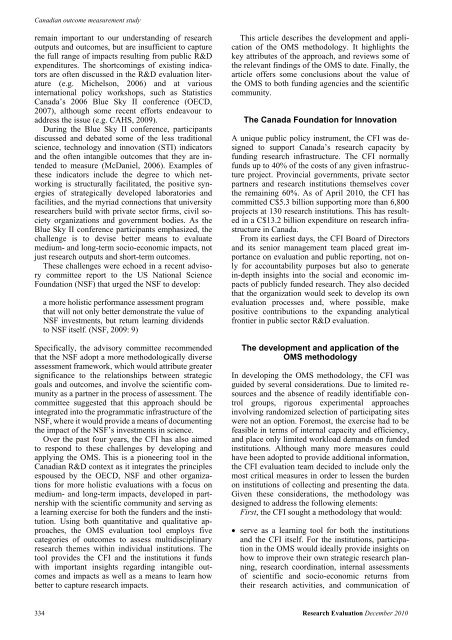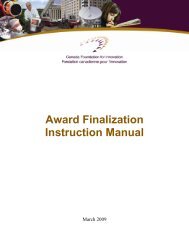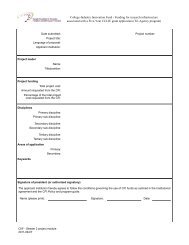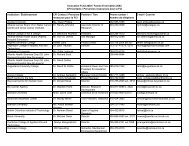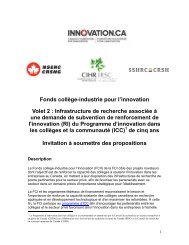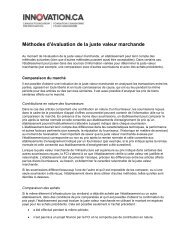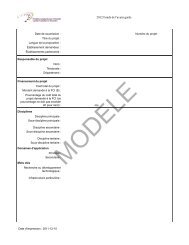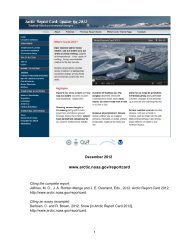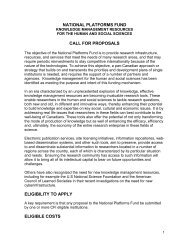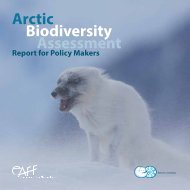Download - Canada Foundation for Innovation
Download - Canada Foundation for Innovation
Download - Canada Foundation for Innovation
You also want an ePaper? Increase the reach of your titles
YUMPU automatically turns print PDFs into web optimized ePapers that Google loves.
Canadian outcome measurement study<br />
remain important to our understanding of research<br />
outputs and outcomes, but are insufficient to capture<br />
the full range of impacts resulting from public R&D<br />
expenditures. The shortcomings of existing indicators<br />
are often discussed in the R&D evaluation literature<br />
(e.g. Michelson, 2006) and at various<br />
international policy workshops, such as Statistics<br />
<strong>Canada</strong>’s 2006 Blue Sky II conference (OECD,<br />
2007), although some recent ef<strong>for</strong>ts endeavour to<br />
address the issue (e.g. CAHS, 2009).<br />
During the Blue Sky II conference, participants<br />
discussed and debated some of the less traditional<br />
science, technology and innovation (STI) indicators<br />
and the often intangible outcomes that they are intended<br />
to measure (McDaniel, 2006). Examples of<br />
these indicators include the degree to which networking<br />
is structurally facilitated, the positive synergies<br />
of strategically developed laboratories and<br />
facilities, and the myriad connections that university<br />
researchers build with private sector firms, civil society<br />
organizations and government bodies. As the<br />
Blue Sky II conference participants emphasized, the<br />
challenge is to devise better means to evaluate<br />
medium- and long-term socio-economic impacts, not<br />
just research outputs and short-term outcomes.<br />
These challenges were echoed in a recent advisory<br />
committee report to the US National Science<br />
<strong>Foundation</strong> (NSF) that urged the NSF to develop:<br />
a more holistic per<strong>for</strong>mance assessment program<br />
that will not only better demonstrate the value of<br />
NSF investments, but return learning dividends<br />
to NSF itself. (NSF, 2009: 9)<br />
Specifically, the advisory committee recommended<br />
that the NSF adopt a more methodologically diverse<br />
assessment framework, which would attribute greater<br />
significance to the relationships between strategic<br />
goals and outcomes, and involve the scientific community<br />
as a partner in the process of assessment. The<br />
committee suggested that this approach should be<br />
integrated into the programmatic infrastructure of the<br />
NSF, where it would provide a means of documenting<br />
the impact of the NSF’s investments in science.<br />
Over the past four years, the CFI has also aimed<br />
to respond to these challenges by developing and<br />
applying the OMS. This is a pioneering tool in the<br />
Canadian R&D context as it integrates the principles<br />
espoused by the OECD, NSF and other organizations<br />
<strong>for</strong> more holistic evaluations with a focus on<br />
medium- and long-term impacts, developed in partnership<br />
with the scientific community and serving as<br />
a learning exercise <strong>for</strong> both the funders and the institution.<br />
Using both quantitative and qualitative approaches,<br />
the OMS evaluation tool employs five<br />
categories of outcomes to assess multidisciplinary<br />
research themes within individual institutions. The<br />
tool provides the CFI and the institutions it funds<br />
with important insights regarding intangible outcomes<br />
and impacts as well as a means to learn how<br />
better to capture research impacts.<br />
This article describes the development and application<br />
of the OMS methodology. It highlights the<br />
key attributes of the approach, and reviews some of<br />
the relevant findings of the OMS to date. Finally, the<br />
article offers some conclusions about the value of<br />
the OMS to both funding agencies and the scientific<br />
community.<br />
The <strong>Canada</strong> <strong>Foundation</strong> <strong>for</strong> <strong>Innovation</strong><br />
A unique public policy instrument, the CFI was designed<br />
to support <strong>Canada</strong>’s research capacity by<br />
funding research infrastructure. The CFI normally<br />
funds up to 40% of the costs of any given infrastructure<br />
project. Provincial governments, private sector<br />
partners and research institutions themselves cover<br />
the remaining 60%. As of April 2010, the CFI has<br />
committed C$5.3 billion supporting more than 6,800<br />
projects at 130 research institutions. This has resulted<br />
in a C$13.2 billion expenditure on research infrastructure<br />
in <strong>Canada</strong>.<br />
From its earliest days, the CFI Board of Directors<br />
and its senior management team placed great importance<br />
on evaluation and public reporting, not only<br />
<strong>for</strong> accountability purposes but also to generate<br />
in-depth insights into the social and economic impacts<br />
of publicly funded research. They also decided<br />
that the organization would seek to develop its own<br />
evaluation processes and, where possible, make<br />
positive contributions to the expanding analytical<br />
frontier in public sector R&D evaluation.<br />
The development and application of the<br />
OMS methodology<br />
In developing the OMS methodology, the CFI was<br />
guided by several considerations. Due to limited resources<br />
and the absence of readily identifiable control<br />
groups, rigorous experimental approaches<br />
involving randomized selection of participating sites<br />
were not an option. Foremost, the exercise had to be<br />
feasible in terms of internal capacity and efficiency,<br />
and place only limited workload demands on funded<br />
institutions. Although many more measures could<br />
have been adopted to provide additional in<strong>for</strong>mation,<br />
the CFI evaluation team decided to include only the<br />
most critical measures in order to lessen the burden<br />
on institutions of collecting and presenting the data.<br />
Given these considerations, the methodology was<br />
designed to address the following elements:<br />
First, the CFI sought a methodology that would:<br />
serve as a learning tool <strong>for</strong> both the institutions<br />
and the CFI itself. For the institutions, participation<br />
in the OMS would ideally provide insights on<br />
how to improve their own strategic research planning,<br />
research coordination, internal assessments<br />
of scientific and socio-economic returns from<br />
their research activities, and communication of<br />
334<br />
Research Evaluation December 2010


